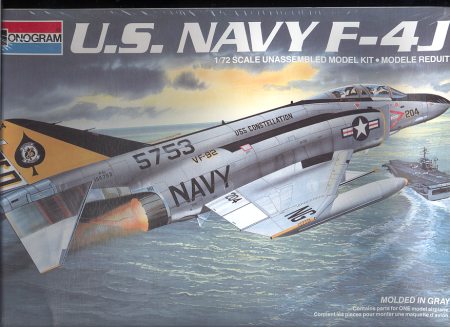
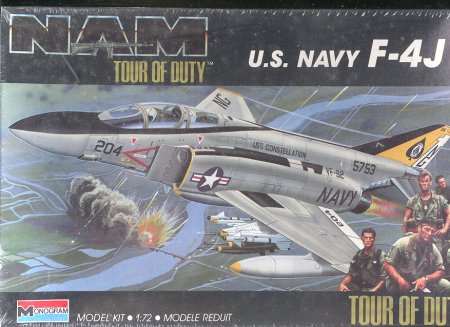
Monogram 1/72 F-4J Phantom II
KIT # | 5440 & 5452 |
PRICE: | $7.50 |
DECALS: | One aircraft, VF-92, in gull grey and white |
REVIEW : | |
NOTES: | Kit is now oop |


HISTORY |

The first of the Phabulous Phantoms to see service was the F4H-1, later called F-4B. VF-74 was the first carrier unit to use the Phantom II and later became the last regular Navy unit to take it to sea, some 25 years later. Navy aircraft don't usually have the longevity that USAF ones do as they are treated much rougher than do the ones for the AF. Also those that crash during operations in the Navy cannot be salvaged as often they are lost at sea.
Anyway, the first F-4Bs were later superceded by the F-4J. The J version incorporated a number of improvements in avionics and structure that the USAF F-4D had. In addition it also had an improved J-79 engine which had longer afterburner nozzles. Gone from under the nose was the infrared seeker that was a mainstay of the F-4B/C/D versions. Still no gun for the Navy, but the aircraft performed very well as an interceptor with its Sparrow and Sidewinder missiles. The Navy's only Vietnam aces flew an F-4J for all of their five kills.
THE KIT |
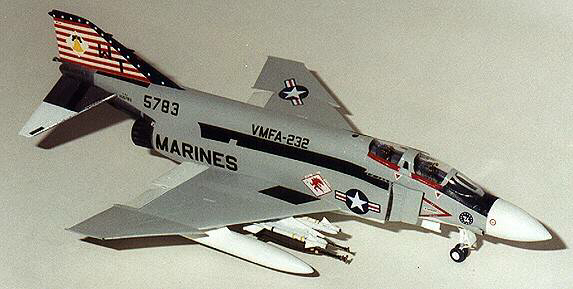
Monogram's excellent F-4J kit is basically a reduced in size version of their super 1/48 kit. (Wait a minute, haven't I read this all before?) While, like most Monogram kits, there are some fit problems, this kit also has superb detail. While released in several different boxings, the basic kit and decals have been the same. Molded in medium grey, it has: raised panel lines, excellent cockpit detailing, a canopy that can be kitted open or closed, crew figures, full weapons load as well as a nice set of Mk 82 bombs with fuse extenders and TERs, and speed brakes/flaps that can be displayed in the lowered position. It also includes the intake ECM antennas and unlike the 1/48 kit has an accurate Navy rear cockpit. Typical of Monogram kits of that time, the decal sheet is terrible as it is too glossy, often out of register, and doesn't stick at all well. Fortunately, the F-4 is an aircraft that is well represented by aftermarket decals.
CONSTRUCTION |
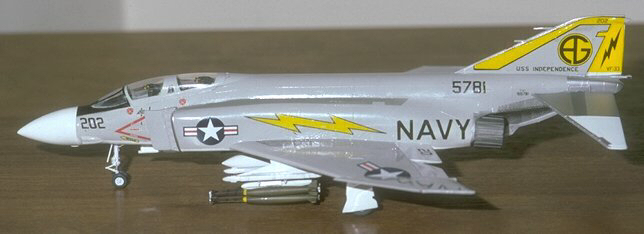
I won't go into any great detail on construction, other than to point out some areas that you will have to be aware of during construction. It seems that there are only so many ways to design an F-4 kit. Monogram's follows the same basic pattern that others have. Mainly a fuselage that is split horizontally, a wing the includes the underside aft part of the airframe, and a kit that needs attention around the intake area. Also like all other F-4 kits I have built (and I have built about 50 of them), there is no need for any nose weight.
The biggest building problem with this kit is the intakes. Unlike other kits, the forward section of the intake is not a separate piece. Instead, the lower part is molded as part of the lower wing. Unfortunately, this just changes where the filler needs to be placed. Like other kits filler is needed at the fuselage/intake join, but with the Monogram kit, a bit more work is required. This is because, for whatever reason, the intakes are not tall enough. This means that a strip of plastic sheet needs to be installed above the lower part of the wing for the intake to fit properly. Nothing that a lot of sanding won't fix, but it does pretty well trash any detail on the intake.
Other places that need filler are where the aft section of the wing joins the lower fuselage. Rarely have I ever gotten a good fit in this locale. Again, filler and sanding are required, destroying the detailing. The final area of concern are the horizontal stabilizers. They are great, but for some reason, Monogram decided to add extra plastic where they fit into the aft fuselage. Without removing this extra stuff, the stabilizers stand proud of the fuselage by about a 1/16 of an inch. On the real aircraft, they almost rub the fuselage they are so close!
Finally, there are the ejector pin marks. There are quite a few of them and they all need to be filled or removed. Unfortunately, they are on things like landing gear struts, inner doors, missile bodies and other places where removal is quite difficult without destroying some detail or another. Some items like missiles can be replaced, but others cannot. It is up to the modeler to decide which to attend to and which to leave well enough alone.
Now this makes the kit sound horrid. Actually it was and still is a superb kit and a bargain for the money spent on them. Until Fujimi started to release their Phantom kits around the mid 1980s, they were the best one could buy, and in terms of detail, were superior to the Fujimi versions, especially in the cockpits. It wasn't until the late'80s/early'90s when the new tool Hasegawa Phantoms appeared that their overall detail level was surpassed. Unfortunately for the F-4 enthusiast, most of these 1/72 kits are no longer as readily available as they used to be and finding them on the store shelves isn't the easy task it used to be as most are now out of production.
PAINT & DECALS |
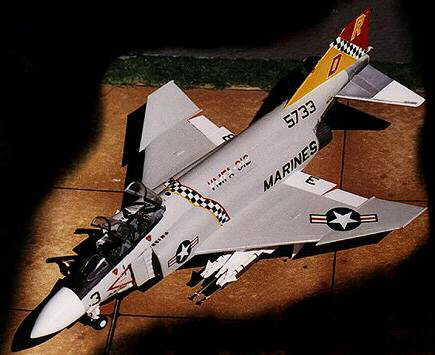
As mentioned earlier, the kit comes with just one decal option, and that is for a VF-92 aircraft from the USS Constellation. The Monogram kit decals are generally pretty poor as they are often off register, are very gloss and do not stick too well. Using setting solutions on them usually causes them to curl into uselessness.
All of these kits use Microscale/Superscale decals in place of the kit ones and were painted with either Gunze Sangyo acrylics or Testors Modelmaster enamel paints.
CONCLUSIONS |
Still a superb representation of the F-4J in 1/72. While not for the beginning builder due to the fit problems, it is recommended for those that want a good kit without having to fork out $20 or more for it. They can be found at swap meets or on-line auctions for under $10.00.
Copyright ModelingMadness.com. All rights reserved. No reproduction without express permission.
Back to Reviews Page 2021